Yoshimura history -30
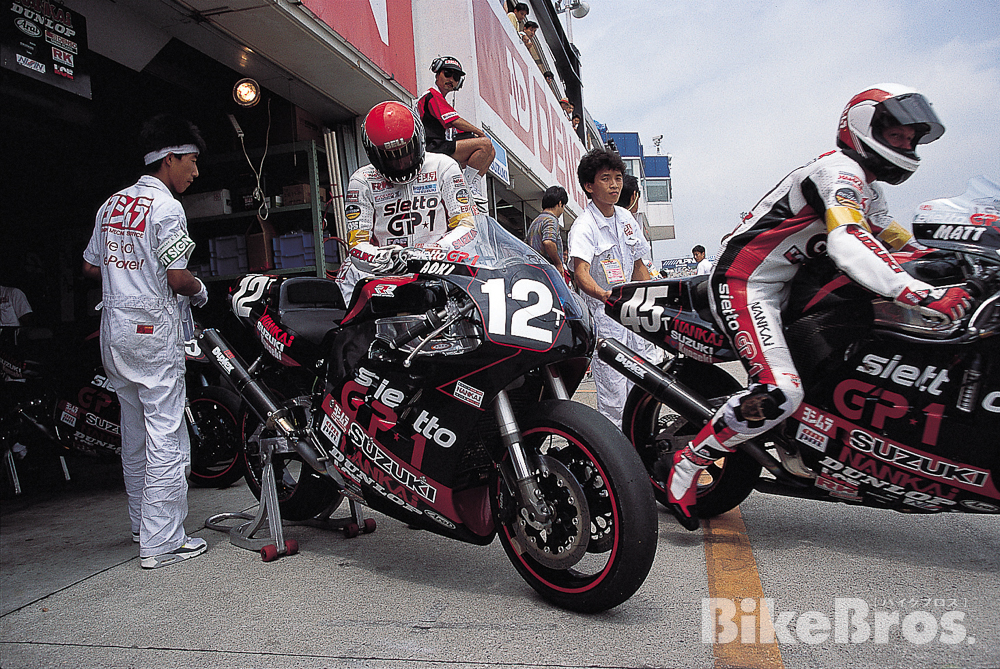
Second riders #12 Tom Kipp and #45 Matt Blair head out onto the track. 1991 was the last Suzuka 8 Hours for the oil-cooled GSX-R750. While the Suzuka 8 Hours race is known for its scorching temperatures, which cause engines to suffer from heat buildup, this year’s final race was held in rainy conditions with a relatively low temperature of 25.4°C. Both Yoshimura bikes experienced crashes, but #12 Aoki/Kipp finished in 9th place, and #45 Martin/Blair in 28th place. Photo courtesy of Osamu Kidachi.
Yoshimura History #30: Farewell, Oil-Cooled GSX-Rs
1990-1991 The End of the Air/Oil-Cooled GSX-R Era
1989 was a great season for Yoshimura. Doug Polen won the TT-F1 and TT-F3 in the All-Japan Championship, while Jamie James won the Superbike and 750 Super Sport in the AMA Championship, both achieving double title success. Meanwhile, rival water-cooled bikes began to show their performance, and the oil-cooled GSX-R750, which entered its sixth year in 1990, was clearly showing its age in terms of design, and its power balance was undeniably inferior.
On top of that, starting in 1990, the AMA Superbike series began homologating not only mass-produced bikes but also so-called limited-edition models. This allowed high-performance bikes like the Honda VFR750R (RC30), Yamaha FZR750R (OW01) and Suzuki GSX-R750R (aka “Double R”) to compete. Unlike the TT-F1, for which only the engine needs to be based on a production model, the AMA Superbike class requires the chassis and exterior (including fairings) to adhere to standard specifications. Therefore, limited edition TT-F1 replica models designed to resemble works racers are the ideal base vehicles for AMA Superbike racing.
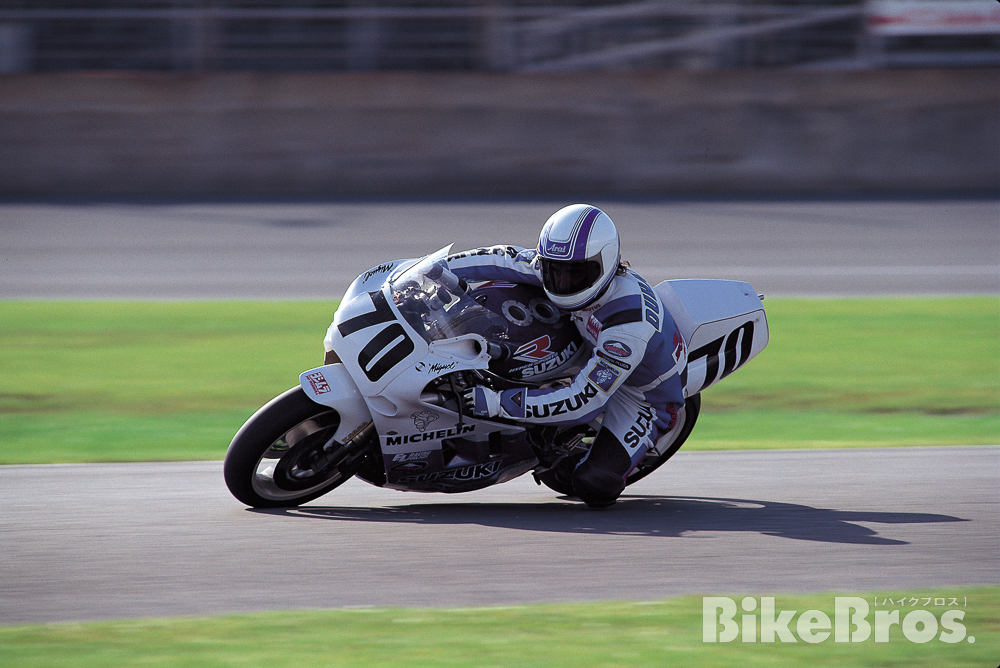
Miguel Duhamel riding a 1990 Superbike through Daytona’s Turn 1. The 1990 AMA specification features two air ducts that run through the fuel tank (silver corrugated hoses visible from the upper cowl ducts to the fuel tank) and a side-mounted oil cooling system. This is a small oil cooler used exclusively for cylinder head cooling, while the larger oil cooler for lubrication system is mounted as usual in front of the engine. Polen was involved in an accident during the testing of this specification. Duhamel crashed and fractured his hand, forcing him to withdraw from the Daytona 200 final. Photo courtesy of Takao Isobe.
Amidst all this, Yoshimura was suddenly struck by misfortune. On February 15, 1990, while testing a superbike for the Daytona 200, an accident occurred at Willow Springs Raceway in Rosamond, near Yoshimura R&D in California (about an hour and a half drive from LA, and about two hours from Chino, where Yoshimura R&D is located).
Polen was riding his Superbike and was coming down the short straight from Turn 4 (the highest point on the track, a right-hand corner with a Budweiser balcony on the outside) toward Turn 5 (a left-hand 90-degree corner) when his throttle got stuck. He tried repeatedly to fix it, but the full throttle revs refused to drop. As he was about to bail off the bike, the tip of his left foot got caught between the sprocket and the chain, severing his toes along with his racing boot. He lost four toes, excluding his little toe.
About a month and a half later, Polen appeared in Daytona. It was his first outing after about half a month in the hospital, followed by home recovery and rehabilitation. His left foot was wrapped in bandages, over which he wore a sneaker converted into a sandal with the tip cut off. “It’s a new model from Nike, the Air Polen. I’ll be back in three or four weeks,” Polen told reporters in both English and Japanese.
Polen met up with his racing buddies and breathed in the distinctive atmosphere of the racetrack, with the pleasant mix of racing machines, engine oil and fuel, which made him even more eager to get back on the track.
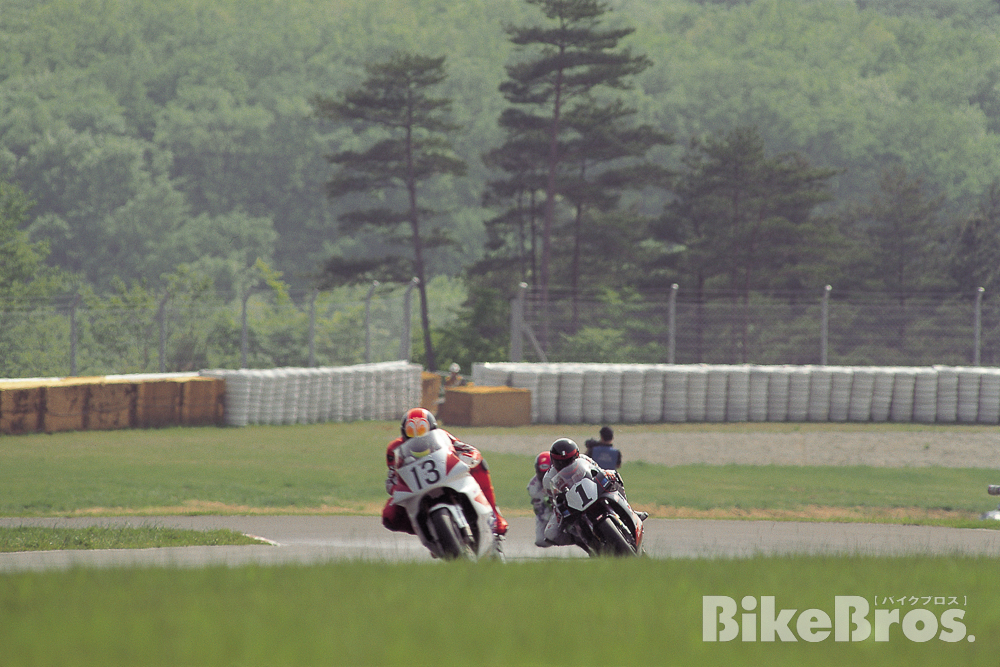
In the 1990 season, Doug Polen raced with the #1 in the All-Japan series. He made his comeback just over two months after a February accident. He not only returned to racing but also proved he could reach top speed. In April at Suzuka, he secured pole position, and in May at the AMA Superbike, he claimed victory. Photo courtesy of Takao Isobe.
True to his word, Polen made his comeback in the 3rd round of the All-Japan Championship at Suzuka (the 2nd of 8 TT-F1 races, with the final on April 22). This time, instead of “Air Polen”, he wore a pair of regular racing boots with padding inside to replace his lost toes. In an amazing feat, he took pole position and finished 4th in the final.
“The accident was a mechanical failure, not my fault. The machine just needs to be fixed, so I’m not afraid. When riding, I move my left foot forward slightly and step on the peg with my heel to put my weight on it. That’s all the adjustment I’ve made. In fact, my riding is better than before,” explained Polen.
Then, Polen made a spot entry in the AMA Superbike Championship Round 2 at Road Atlanta (May 6) and won the race. It had been only three months since his accident.
Following this, Polen returned to Japan to compete in the opening round of the TT-F1 FIM Cup Series at Sugo, where he took pole position with an all-time lap record. His Yoshimura teammate Katsuro Takayoshi also participated in the event but crashed during practice and was unable to compete. The final race was a grueling 50-lap event, requiring one pit stop. During that pit stop, Yoshimura experienced an unusual delay, and Polen, who suffered from peeling skin from a previous surgery, finished the race in 7th place.
Polen continued to compete in All-Japan series, finishing 4th in the Round 7 Suzuka 200km (June 10), 2nd in Round 8 at Tsukuba (June 24), and retiring in Round 9 at Sugo (July 8) due to an igniter failure. The rival water-cooled V4 Honda RVF750 team (Kenichiro Iwahashi and Shoji Miyazaki) was a formidable opponent, consistently finishing ahead of Yoshimura.
As the All-Japan series enters its summer break, attention turns to the 13th Suzuka 8 Hours (final race on July 29). The 1989 and 1990 endurance series were held as part of the FIM Cup, not the World Championship. Yoshimura fielded two bikes: #12 Doug Polen / Miguel Duhamel (AMA Superbike contract) and #45 Katsuro Takayoshi / Rick Kirk. In the final stint of the race, at 7:15 PM, Polen’s bike #12, which was running in 5th place, began to emit white smoke. It seemed like an engine issue. Lap times dropped by 10 seconds, and the engine sounded unusual. The pit sign read “12 GO +42 L4.” The team decided not to bring the bike into the pit. They decided that if the engine stopped, it would be impossible to restart it. Polen, aboard the bike, felt the same way. The officials were about to give him the black flag (order to pit), but Yoshimura mechanics desperately tried to persuade them not to. The checkered flag dropped, and #12 finished in 6th place.
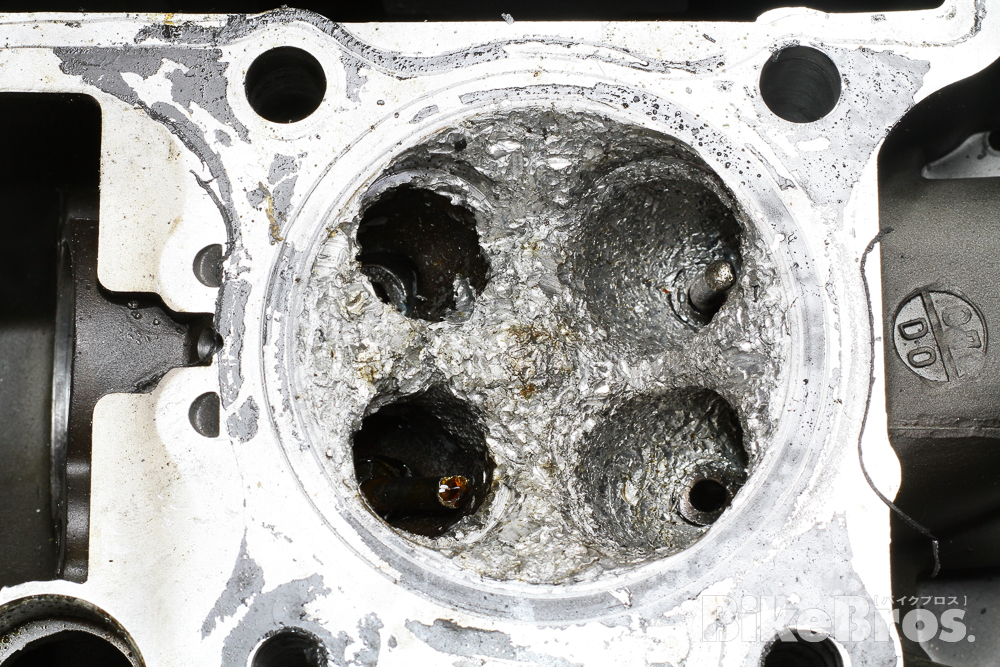
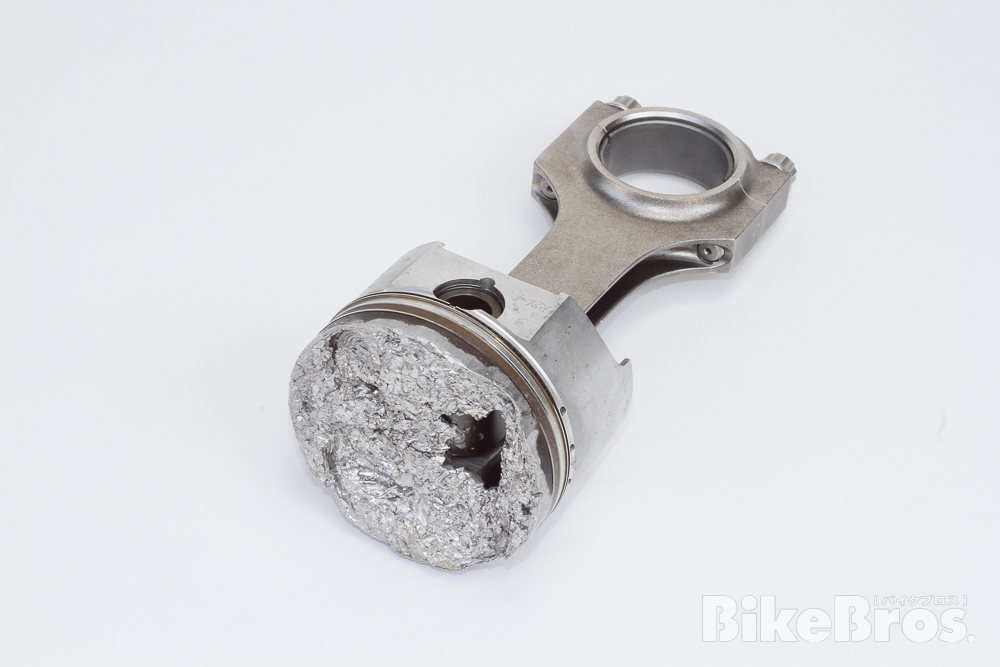
1990 Suzuka 8H #12 Yoshimura Suzuki GSX-R750’s severely damaged cylinder head (No. 3). The cause was a valve drop, with all four valves completely gone, and a large hole had opened in the crown of the forged piston. It was a miracle that the engine didn’t stop and the bike managed to finish the race in such a condition. The Carrillo H-type steel connecting rods were adopted after the 1986 Daytona race, when Satoshi Tsujimoto’s bike suffered an engine blowout due to structural weakness in the connecting rods. Carrillo rods are known for their strength and excellent balance. Photo courtesy of Tomoya Ishibashi.
The cause of the white smoke was a valve drop in cylinder #3. The piston and cylinder head were in a mess, with holes in the piston crown and all four intake and exhaust valves completely gone, but luckily the three piston rings were intact, and both the small and big ends of the connecting rod were working smoothly. In short, although the #3 cylinder was dead and the bike was running on three cylinders, it was able to maintain full stroke. Meanwhile, #45 Takayoshi/Kirk finished in 12th place.
After the Suzuka 8 Hours, Polen entered the Superbike World Championship Round 8 at Sugo (August 26). However, he crashed heavily in Heat 1 after slipping on oil from his own bike. The red flag came out, and the results of Heat 1 were decided based on the positions one lap before the crash, with Polen finishing 8th. He missed Heat 2 due to injuring his left leg.
In the resumed All-Japan TT-F1, Polen finished 2nd in Round 13 at Suzuka (September 9), 4th in Round 15 at Sugo (October 7), and 6th in the final round at Tsukuba (Round 16, October 28), ending the All-Japan season without a victory but still finishing 3rd in the overall standings.
Meanwhile, Yoshimura’s Masanao Aoki (former Mirage Kanto rider) entered the All-Japan TT-F3 and finished 4th in the rankings.
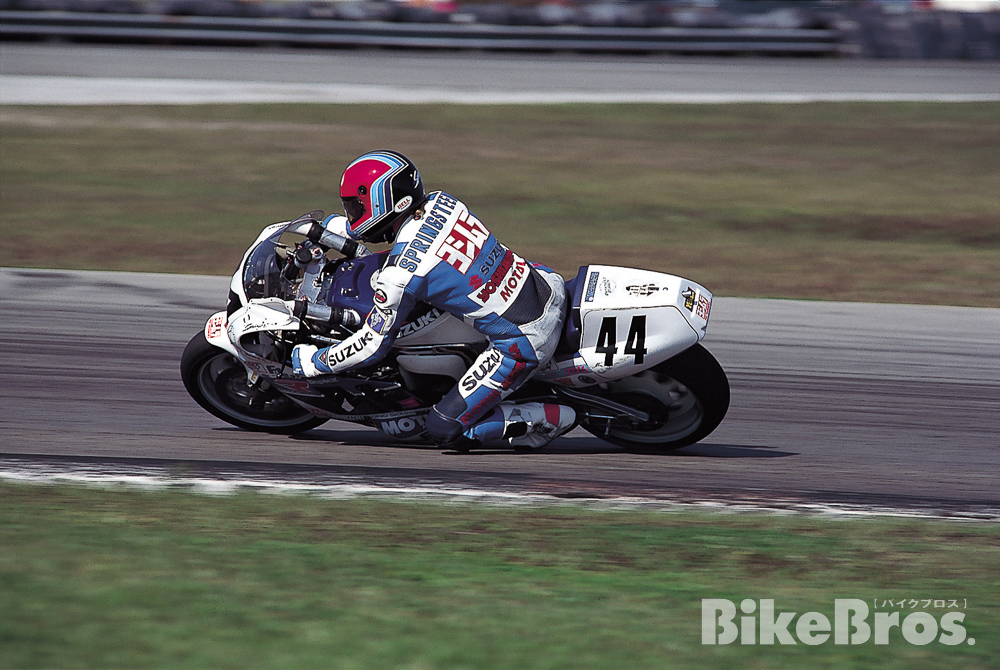
Jay Springsteen, the king of flat track racing and an American hero, riding a Yoshimura Suzuki in the 1990 season was a hot topic. This was something he had passionately desired, and Yoshimura R&D provided him with the latest machine. His riding style is almost entirely “lean-with”, but having been honed on left-hand oval tracks, he was exceptionally fast in left-hand corners even on paved surfaces. At the Daytona 200, he skillfully secured the top Suzuki finish in eighth place. Photo courtesy of Takao Isobe.
In the AMA Superbike (8 rounds), Duhamel won the Round 7 at Topeka but finished 10th in the overall standings. Duhamel also won one race in the AMA 750 Supersport and finished 7th in the overall standings. Meanwhile, American Flat Track legend Jay Springsteen (three-time AMA Grand National Champion from 1976 to 1978) rode a Yoshimura Suzuki and finished 8th in the season-opening Daytona 200, as the highest-placed Suzuki rider.
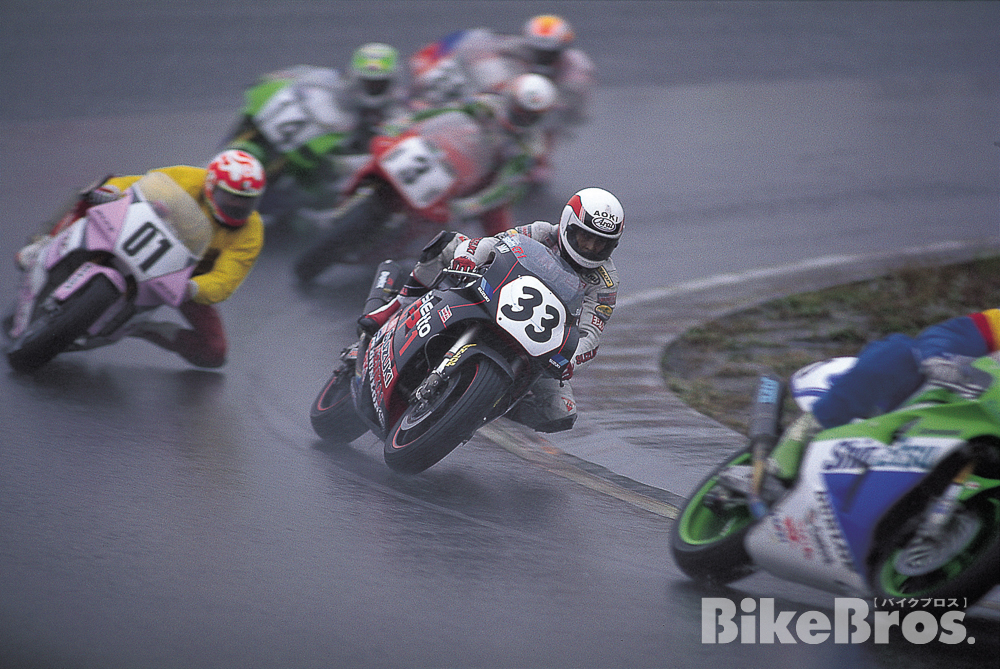
In the 1991 season, #33 Masanao Aoki became Yoshimura’s regular rider for TT-F1. He rode well, but the inferiority of the oil-cooled GSX-R750 was clear. Even so, in the rain-soaked final race of the final round, the MFJ Grand Prix, he beat #01 Niall Mackenzie aboard a Yamaha FZR750 in a close battle to finish 3rd on the podium. #3 Polen, who made a spot entry with a Ducati 888 Superbike, took pole position with an all-time lap record in qualifying, but finished 10th in the wet final. Photo courtesy of Takao Isobe.
1991 saw the departure of Polen, the team’s absolute ace, to Ducati. Yoshimura appointed Aoki as its ace rider for the All-Japan TT-F1, along with Steve Martin. Mike Smith, Dominique Sarron, and Matt Blair were brought in on a spot basis to explore their chemistry with the Yoshimura Suzuki TT-F1 machine.
In the 1991 All-Japan TT-F1 (10 of 17 rounds in the All-Japan series), Aoki finished 16th in the opening round (Suzuka 2 & 4, March 3), 12th in Round 3 (Suzuka Road Race, April 21), 5th in Round 5 (Sugo Road Race, May 12), retired in Round 7 (Suzuka 200km Road Race, June 9), 5th in Round 8 (Tsukuba Road Race, June 23), and 21st in Round 9 (Sugo Road Race, July 7). After the Suzuka 8 Hours, he finished 4th in Round 14 (Suzuka International Race, September 8), 31st in the (TBC Big Road Race at Sugo, October 6), and 3rd in the final round (MFJ Grand Prix at Tsukuba, October 27), finishing 7th in the overall standings. Martin finished 17th in the overall standings.
For the 14th Suzuka 8 Hours (Round 3 of the World Endurance Championship), Yoshimura entered the race with #12 Aoki/Kipp and #45 Martin/Blair. #45 suffered a crash and fire with Martin, but returned to the race after major repairs in the pit. #12 also experienced a crash and fire with Kipp during the final stint, but restarted. #12 finished in 9th place, and #45 in 28th place, successfully completing the race.
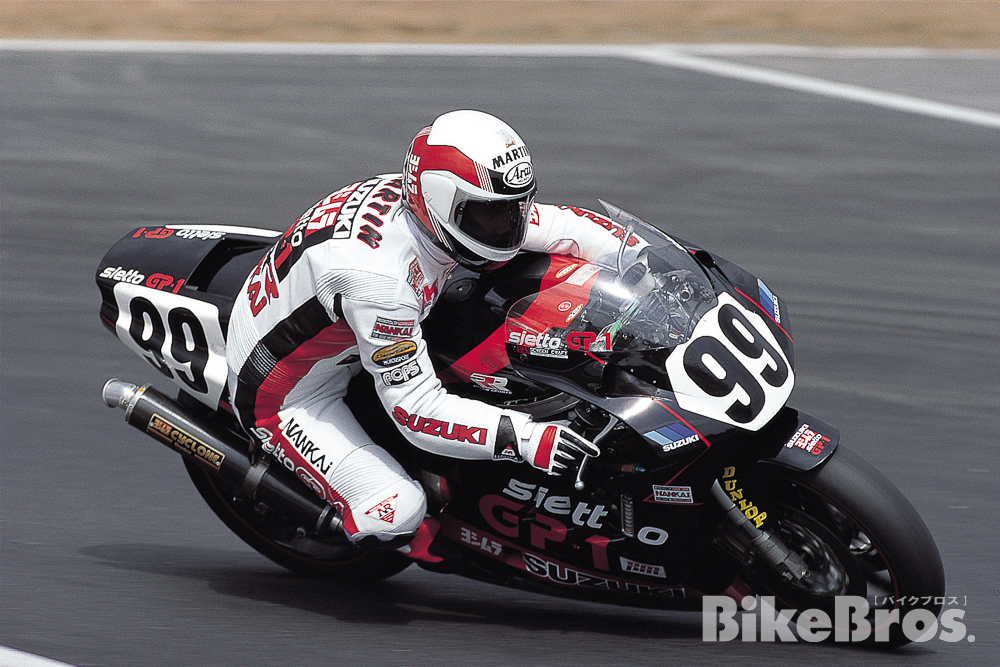
#99 Steve Martin was essentially a regular rider for Yoshimura in the All-Japan TT-F1 series. He finished 10th at best and ranked 17th overall in the 1991 season, failing to demonstrate his true potential. Photo courtesy of Osamu Kidachi.
In the 1991 AMA Superbike Series, Yoshimura took on the challenge with a young duo of Mike Smith and Tommy Lynch. Neither rider was able to secure a victory, with Lynch finishing 11th and Smith 13th in the overall standings.
In TT-F1, starting from 1991, the previous rule allowing “a 1% increase in displacement through bore enlargement” was no longer permitted. While AMA Superbike allowed a 1mm increase in bore, the cylinder bore of the TT-F1-spec GSX-R750 was reduced from φ70.3mm (756.12cc with 48.7mm stroke) to stock φ70mm (749.68cc with 48.7mm stroke). As a result, the “air/oil-cooled” GSX-R’s were clearly at a power disadvantage compared to its water-cooled rivals.
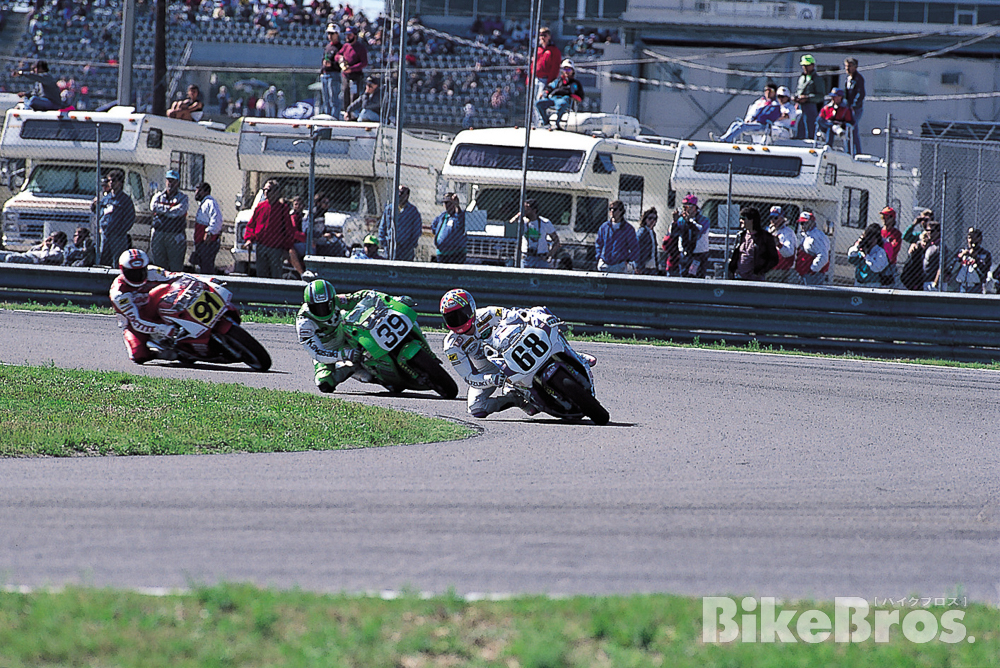
Mike Smith, aboard the #68 GSX-R1100, is the champion of Formula USA (unlimited displacement class) organized by the Western Eastern Roadracers Association and signed with Yoshimura R&D in 1991. At the Superbike season opener, the Daytona 200, he crashed on the 10th lap. He also made a spot appearance in Round 3 of the All-Japan Championship at Suzuka on April 21, but retired. He was plagued by injuries throughout the season. Behind him, #91 is Grand Prix rider Rob McElnea on a Yamaha FZR750R (OW01). Photo courtesy of Tomoya Ishibashi.
The issue of heat buildup with the oil-cooled GSX-R750 has been a challenge since its debut. For the TT-F1, two types of oil coolers were installed (a large curved one for cylinder head cooling and a medium-sized one for lubrication), with careful consideration given to their positions, such as stacking two units front and rear (1990 model) or vertical configurations (1991 model) and other innovative designs. For the 1990 model used in AMA Superbike, the oil cooler for cylinder head cooling was mounted on the right side of the chassis. This was a solution to avoid increased aerodynamic drag caused by larger and multiple oil coolers, with the expectation of improved performance on high-speed tracks such as Daytona.
In the All-Japan and FIM races, the new water-cooled GSX-R750W was introduced in 1992, but in the AMA races, as with the oil-cooled GSX-R750, homologation was delayed by one year, forcing the team to compete with the oil-cooled model in the 1992 season. To tackle this, Yoshimura R&D of America came up with an innovative solution: adding cooling fins to the cylinders, similar to those found on air-cooled engines. This modification proved effective, as David Sadowski finished 4th in the Daytona 200, the longest high-speed race in AMA Superbike series. Despite the power disadvantage of the oil-cooled GSX-R750, Sadowski secured 12th place in the overall standings.
The “air/oil-cooled” GSX-R750 thus enjoyed a long and distinguished presence in the All-Japan and FIM championships from 1985 to 1991, and in the AMA road racing series from 1986 to 1992, carving its name into the history of four-stroke racing motorcycles.
Stories and photos supplied by Yoshimura Japan / Osamu Kidachi / Takao Isobe / Tomoya Ishibashi
Written by Tomoya Ishibashi
Edited by Bike Bros Magazines
Published on October 11, 2024
[ Japanese Page ]
